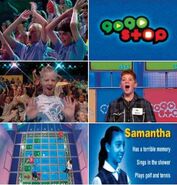| Host | |
| Jesse Tobin | |
| Broadcast | |
| Seven Network: 2004–2007 | |
| Packager | |
| Ambience Entertainment | |
Go Go Stop was a Children's Game Show where contestants from three schools answer questions, to get to the end of the tricky go or stop 5x6 plasma game board.
Gameplay[]
Thirty plasma screens made up the game zone, arranged in a rectangle five screens wide and six screens high. The players had to answer questions with two multiple-choice answers (sometimes true-or-false questions) with control pads attached to their wrists. They could take their time, but the correct-answering players were the only ones who were allowed to move down the game zone. Correct answers also scored points, without penalties for incorrect answers. The first player to choose the correct answer went first on the game zone.
In earlier episodes, the audience could yell out the answer. This was soon scrapped, because the players all kept choosing the audience's answer.
Before the round began, the players each selected a space at the top of the game zone. A correct answer to each question meant that they could step on a plasma screen, which lit up a command that the contestant then had to obey.
Contestants[]
Each school had eight contestants selected at a school audition. There were five students for each day of the week, and three reserved students for sick, injured, or unavailable students. On several occasions, a student wearing clothes with brand names on them resulted in them being replaced with a reserve. The students who competed each day were always seated at the very top row of each school.
Rounds[]
Round 1: Three-Way Scramble #1[]
This round is named so because all three players competed. Correctly answering a question scored ten points, and the first player to step off the game zone scored twenty-five points and ended the round.
Round 2: Three-Way Scramble #2[]
Played just like the first Three-Way Scramble, except that correct answering a question was worth fifteen points. Also there were more hazards on the game zone, making it harder to reach the end. Stepping off the game zone was still worth twenty-five points.
At the end of this round, the player with the lowest score was eliminated.
Round 3: Head to Head[]
This round is named so because there were only two players left, since the other one was eliminated in the previous round. Correctly answering a question was worth twenty points, and stepping off the game zone was worth fifty points.
The player with the lowest score would be eliminated. If the round ended in a tie, a tie breaker would be played. There were two types of tiebreakers that were used throughout the programme's run.
- In the first two seasons, the players stood facing away from each other, with Jesse in between them. He would ask them a true-or-false question. The players would put a thumbs up for true, and a thumbs down for false. Once one player was correct and the other was incorrect, the player who was correct would move on.
- In the last two seasons, Jesse read a series of clues to a famous person or thing. When a player thought they knew the answer, they would say the name of their school out loud to get Jesse's attention, then they would give their answer. A correct answer meant that they would move on, but a wrong answer meant that the opponent would move on.
Final Round: The Run for Fun[]
In this round the top scoring player of the day received a chance to win prizes for themselves. On each of the five plasma screens at the front of the game zone, there was a category, each containing five true-or-false questions. There were five prizes hidden in the game zone. Before the round started, their locations would be revealed for a few seconds.
During the round, the player had one minute to earn as many prizes as possible.
When the clock started, the player stood on a category, shouted out its name, and Jesse read the question. After the question was completely read, the player had to run to the other end of the game zone and jump on the screen that said "true" or "false" and yell out the word. Giving the incorrect answer meant another question would be asked, while giving the correct answer meant the player could jump on the screen they thought had a prize, and they had to yell stop to reveal it. If the screen had a prize, the player won it; if it didn't have a prize, or if all five questions were asked, the prize was lost and the category couldn't be used again. As long as there was time left on the clock, they player would keep trying to earn the prizes in any categories that were yet to be played. The round continued until time ran out, all five prizes were won, or all five categories were played.
At the end of each round, Jesse and the players had to stand in the position marked on the ground by white dots.
As mentioned, all three schools competed for a whole week, and the school with the most points at the end would be the winner and receive grand prizes.
Commands[]
| Name | Command | Appearences |
|---|---|---|
| Go | The player could take a step forward, diagonally forward or to the side | Three-Way Scrambles #1 and #2 and Head to Head |
| Stop | The player had to stop on that screen and their turn ended | Three-Way Scrambles #1 and #2 and Head to Head |
| Bonus Screens | They awarded ten or fifteen points, depending on the round, but then they became stop screens | Three-Way Scrambles #1 and #2 |
| Miss A Turn | The player couldn't answer the next question and their turn ended. | Three-Way Scrambles #1 and #2 and Head to Head |
| Arrows | The player had to go to the screens they were pointing at | Three-Way Scrambles #1 and #2 and Head to Head |
| Back Two | The player had to go directly back two screens, not the last ones they were on. | Three-Way Scramble #2 and Head to Head |
| No Entry | Only appearing on the top row, the player couldn't enter the game zone at that screen and had to select a new entry position | Three-Way Scramble #2 and Head to Head |
| Start Again | The player had to step off the game zone and start the round all over again. | Head to Head |
| Swap Places | The two players on the game zone had to switch places. In the first two seasons, the players had to take each other's turns, with the screen acting as a stop. In the last two seasons, this was changed to having to simply swap places so that the runs could continue | Head to Head |
| Try Again | The player had to go back to the bottom of the game zone and choose a new category, but did not receive a prize for the preceding question. | The Run for Fun |
Pics[]
Set[]
Link[]
Website for Go Go Stop Go Go Stop Ambience Entertainment site






